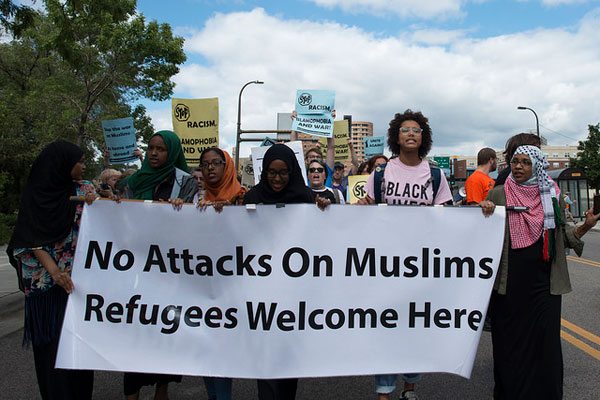
May 14, 2018; The Republican (Springfield, MA)
Last year, NPQ reported that some refugee resettlement agencies were having a difficult time hanging on as temporary bans, ceilings on refugee arrivals, and other actions meant to stem the arrival of newcomers at risk in their own countries were implemented one after another. The agencies had built up skilled staff over the years, but when the flow of refugees was cut in half, federal payments fell too, and it was clear that holding on organizationally was going to be tough—but necessary.
Expecting that some of the bans and exclusions would not last, the agencies tried to take temporary measures such as redeploying dedicated staff members to other programs. Now, we’re starting to hear about program closures. In Minnesota, earlier this month, Catholic Charities of Minnesota and St. Paul announced it was closing its refugee program, which had seen numbers drop significantly since 2016, when 319 were served. Last year, they served 167; so far this year, their programs have served only 56 refugees. This reflects the federal halving of the numbers of refugees allowed in on an annual basis. Lutheran Social Service of Minnesota has always served more refugees than Catholic Charities, but there is no indication whether it will be picking up the slack either now or in the future when this country begins to reoffer asylum at previous rates.
The government extended a pause on arrivals from 11 countries, including Somalia—a top country for refugees coming to Minnesota—and suspended indefinitely a family reunification program used by many refugees already resettled here to reunite with spouses and children. Since the start of the federal fiscal year on Oct. 1, 2017, through February 2018, about 240 refugees arrived in the state, compared with 1,180 during the same period the previous year.
The agencies receive federal funding for each refugee they resettle, and the slowdown in arrivals has triggered staff layoffs and other cuts in these organizations locally. Lean stretches are not anything new, said Ryan Allen, an expert on resettlement at the University of Minnesota’s Humphrey School of Public Affairs, noting a dramatic drop after 9/11 as an example.
But, he said, “the big difference here is that for the foreseeable future, it’s going to be more of the same.”
In Springfield, Massachusetts, Maxine Stein, the president of Jewish Family Services of Western Massachusetts, which has been settling refugee families for almost eighty years, says, “All refugee resettlement efforts in the country are undergoing a tremendous amount of stress. Emotional stress, financial stress and just a general stress of how to continue to deliver services of the highest quality to our clients in these times.”
Sign up for our free newsletters
Subscribe to NPQ's newsletters to have our top stories delivered directly to your inbox.
By signing up, you agree to our privacy policy and terms of use, and to receive messages from NPQ and our partners.
A lot of our staff are former refugees themselves who have come from these countries. We are not seeing the refugees arriving as frequently or in as strong of numbers as we would like to see. That is extremely stressful for everyone, and it is also stressful from a business standpoint because people are worried about their jobs. In that way, I am protective of our staff and on a larger scale very, very worried about what is happening with the global crisis at a time when it is very difficult to be as effective as a refugee resettlement agency. The government is making it very difficult.
Stein says there’s no option to just shrink, because the feds expect every resettlement agency to be able to guarantee access to housing and other resources sufficient to meet the needs of the newcomers. “Prior to any fiscal year, every refugee resettlement agency has to be clear about how many refugees they are prepare(d) to handle in the upcoming year. In the past, an agency could say only 40 or 60, but now the state department is saying that unless you can write on the application that you can manage at least 100, you are being shut down.”
According to Stein, these numbers have a big impact on funding. “We have had a tremendous loss in government grants—several hundred thousand—just by the sheer lack of…refugees.” This fiscal year, which began in October, JFS will have served around 55 refugees at month’s end, compared with 175 at a similar time several years ago.
Still, Stein says, they remain busy helping families negotiate unfamiliar systems and address crises.
“This is a time in which it is easy to abandon the work, and I think boards—rightly so— are worried. They are the fiduciary guards of an agency, and I think they are under a lot of pressure across the country. At the same time, we have to hold on so that we are there when the numbers do come back and that we can continue to take care of all of these people we feel we have such a moral obligation to. We brought them to resettle them and we have to help them succeed.”
This speaks once again to the complex stresses that nonprofit leaders are under day-to-day. The field of refugee resettlement struggles to maintain an infrastructure that’s badly needed to save the lives of those with whom they work, even as the federal government provides a hostile environment in which to do so, restricting access to entry and funds. It is worth remembering that factors like these are always at work in many nonprofits, as impossible choices must be met with pure dedication to mission.—Ruth McCambridge













